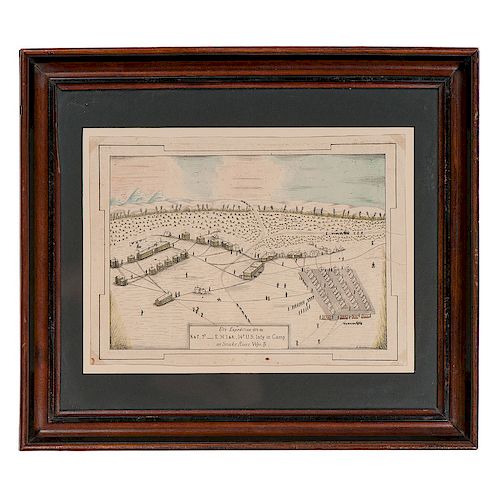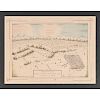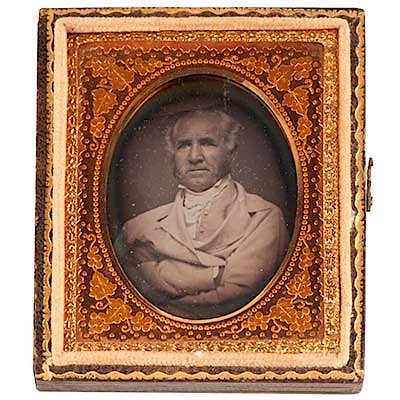Drawing of the 1879-80 Ute Expedition Camp of the 9th and 14th US Infantry on Snake River, Wyoming Territory
About Seller
6270 Este Ave.
Cincinnati , OH 45232
United States
With offices in Cincinnati, Cleveland and Denver, Cowan’s holds over 40 auctions each year, with annual sales exceeding $16M. We reach buyers around the globe, and take pride in our reputation for integrity, customer service and great results. A full-service house, Cowan’s Auctions specializes in Am...Read more
Two ways to bid:
- Leave a max absentee bid and the platform will bid on your behalf up to your maximum bid during the live auction.
- Bid live during the auction and your bids will be submitted real-time to the auctioneer.
Bid Increments
| Price | Bid Increment |
|---|---|
| $0 | $25 |
| $500 | $50 |
| $1,000 | $100 |
| $2,000 | $250 |
| $5,000 | $500 |
| $10,000 | $1,000 |
| $20,000 | $2,500 |
| $50,000 | $5,000 |
| $100,000 | $10,000 |
About Auction
Nov 16, 2018
Cowan’s Fall American History: Premier Auction features over 200 lots including early photographs, documents, manuscripts, broadsides, flags, and more dating from the Revolutionary War period to the mid-20th Century, many representing important landmark moments in American history. Cowan's Auctions dawnie@cowans.com
- Lot Description
Pencil, ink, and watercolor on paper. 8.25 x 11.5 in., professionally framed to 14.5 x 16.5 in. Signed "L. Leblanc" at l.r.
Title block with "Ute Expedition. 1879-80. / K & F 9th - E.H.I & K., 14th US Infy in Camp / on Snake River, Wyo. Ty." Drawing showing log buildings on the left, rows of tents on the right. Men doing laundry, cooking, herding horses, bringing in wagon loads of supplies.
The Ute Expedition (also known as the Ute Wars) was part of the many skirmishes and battles fought between native peoples and Euro-Americans following the Civil War. Colorado populations were growing and the new Governor had campaigned on a "Utes Must Go" theme. The new settlers wanted the rich lands then occupied by native groups, so the men in power exaggerated (and probably invented) stories about Ute depredations to gain the support of the Federal government. Nathan Meeker, who had no experience with American Indians, was also new at the post of Indian agent at the White River Ute Reservation. He attempted to assimilate the people under his influence, forcing them to become farmers and Christians. The Utes, long-time bison hunters and gatherers (with their own religion) began to bristle and eventually revolted against this pressure.
When Meeker plowed a field for agriculture that the Utes had used to graze and race horses, violence erupted. On September 29, 1879, the Indian agency was attacked, Meeker and his 10 male employees were killed, and his wife, daughter and some other women were kidnapped and held for 23 days as hostages. Ute Chief Ouray (Uncompahgre), who was not involved in the conflict, tried to negotiate peace and did secure the release of the women.
Major Thomas Thornburgh led a command of just under 200 men, soldiers and militiamen, to the White River Agency in response to Meeker's request for assistance. Most of the men were from the 3rd and 5th Cavalry and 4th Infantry. They were attacked at the north edge of the reservation, before they could even reach the agency buildings. The Major and 13 others, including all officers above the rank of Captain, were dead in minutes. The survivors took up positions behind wagons, dead animals, and any other shelter they could find. Thirty-five Buffalo soldiers initially got through to reinforce the embattled men. The larger force of 350 relief troops had to come by train from Forts Steele and Russell, a greater distance away. They arrived on October 8 and were able to rescue the trapped forces and put down the uprising. They built a camp on the White River and spent the winter at the site of the former Indian agency. The site was occupied until 1883. Likely this was the group of soldiers encamped in this drawing. The Utes were ultimately ordered out of Colorado, but some ended up staying because there was no place for them to go.
Recently framed and mounted with conservation glass. Not removed from frame for examination. There appear to be repaired tears along the right margin. Otherwise fine.Condition
- Shipping Info
-
Buyers are required to pay for all packing, shipping and insurance charges. Overseas duty charges are the responsibility of the successful Bidder. Be aware that for larger and/or valuable items, shipping charges can be substantial. - If there is no shipping amount on listed your invoice, you will need to make arrangements to pick up or ship your purchase through an alternative shipping company. Our shipping department can be contacted at 513.871.1670 (ext. 219) or email shipping@cowans.com. - Shipping charges include insurance for your order while in transit. If you have private insurance we will adjust your charge to include only packing and shipping. - Please allow 14 – 21 days after payment to package and ship your purchase as carefully as possible.
-
- Buyer's Premium



 EUR
EUR CAD
CAD AUD
AUD GBP
GBP MXN
MXN HKD
HKD CNY
CNY MYR
MYR SEK
SEK SGD
SGD CHF
CHF THB
THB












